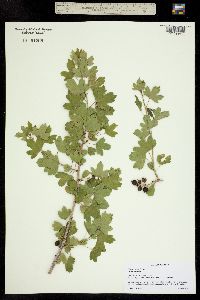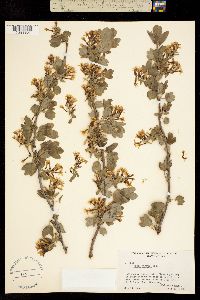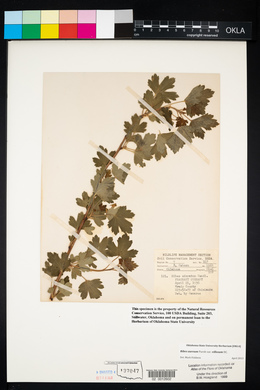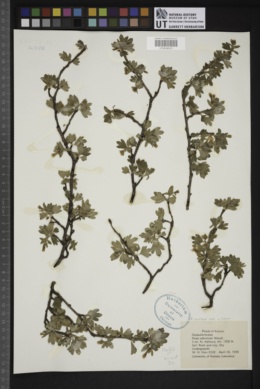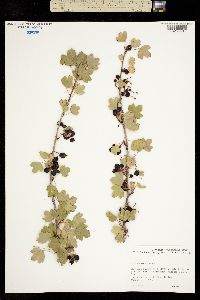Ribes aureum
|
|
|
|
Family: Grossulariaceae
Golden Currant
[Ribes palmatum, moreRibes tenuiflorum] |
Plants 1-3 m. Stems erect, glabrous or finely puberulent or villous, glabrescent; spines at nodes absent; prickles on internodes absent. Leaves: petiole (0.4-)1-3(-4.8) cm, margins of young leaves often with slender extensions like multicelled hairs, surfaces finely pubescent, glabrescent; blade broadly deltate-ovate to obovate, 3(-5)-lobed, cleft less than to slightly more than 1/2 to midrib (sometimes proximal leaves again shallowly lobed), (1-)1.6-3.6(-5.7) cm, base broadly cuneate to somewhat cordate, surfaces sometimes with colorless or yellowish, nearly sessile glands, finely pubescent or glabrous, glabrescent, lobes oblong-rounded, margins entire or with 2-5 rounded teeth, apex acute to obtuse. Inflorescences ascending to reflexed, 5-18-flowered racemes, 3-7 cm, axis glabrous, finely pubescent, or densely villous, flowers evenly spaced. Pedicels jointed, 2-8 mm, glabrous or densely villous; bracts broadly deltate to obovate (similar to leaves), 4-9 mm, glabrous or densely villous. Flowers: hypanthium yellow to yellowish green, narrowly tubular, 6-20 mm, glabrous; sepals not overlapping, spreading, usually not reflexed, golden yellow, oblong-elliptic, 3-8 mm; petals connivent, erect, yellow to orange or deep red, oblong-obovate, not conspicuously revolute or inrolled, 2-3(-4) mm; nectary disc not conspicuous; stamens nearly as long as petals; filaments slightly expanded at base, 0.9-1.5(-2.2) mm, glabrous; anthers white, oblong, 1.1-2 mm, apex minutely apiculate; ovary glabrous; styles connate almost to stigmas, (8.5-)9.8-12.5 mm, glabrous. Berries palatable, usually red, orange, brown, or black, rarely yellow, globose, 5.2-10 mm, glabrous. 2n = 16. Ribes aureum was introduced into cultivation in Europe early in the nineteenth century (F. V. Coville 1903). It is a major host of pinyon blister rust in Arizona, Colorado, and Utah, and of pinyon leaf rust in New Mexico (E. P. Van Arsdel and B. W. Geils 2004). Ribes aureum is a variable complex and the varieties may seem to intergrade. In California, var. aureum occurs in sagebrush scrub or coniferous forests at higher elevations (800-2600 m) than var. gracillimum; the sepals of var. aureum are longer than those of var. gracillimum (5-8 mm versus 3-4 mm), and its hypanthium is noticeably shorter relative to the sepals. Leaves of var. aureum are more highly lobed and are sparsely glandular in the Pacific Northwest and less lobed and more densely glandular in the southwest (H. D. Hammond, pers. comm.). In most of its range, var. villosum is so conspicuously villous as to be unmistakable; in the west some plants with strikingly long hypanthia are scarcely villous.
Martin and Hutchins 1980, Kearney and Peebles 1969 Common Name: golden currant Duration: Perennial Nativity: Native Lifeform: Shrub Wetland Status: FAC General: Erect, unarmed shrub to 2 m tall with glabrous branchlets, these tan to reddish orange when young and gray with age. Leaves: Alternate, blades 15-50 mm wide, cuneate to shallowly cordate at the base, mostly 3-lobed with rounded lobes, entire to toothed only on terminal lobes, with the entire upper surface glabrous and the lower surface puberulent to glabrate, on glabrous petioles 0.5-2.5 cm long. Flowers: Racemes with 5-18 flowers of a smooth cylindrical hypanthium, 6-10 mm long, with sepals 5-8 mm long, 2-3 times as long as the spreading yellow petals, with stamens that are about equal to the petals. Fruits: Globose glabrous berry, black to red with age, but yellow to orange when fresh, 6-8 mm in diameter. Ecology: Found in moist soils on slopes in canyons or along streams from 4,000-7,000 ft (1219-2134 m); flowers March-June. Notes: Distinguished from other species of Ribes by its being unarmed, it is an earlier spring bloomer. Additionally, the large 3-lobed leaves are key, no other species of Ribes has leaves this large. Ethnobotany: Used on sores and for swellings, applied to snakebites, the berries eaten raw, dried and stored, made into cakes, jams, and the stems were used for arrows. Etymology: Ribes is from the Syrian or Kurdish ribas, which is derived from an old Persian word, while aureum means golden. Synonyms: None Editor: SBuckley, 2010 From Flora of Indiana (1940) by Charles C. Deam Rhus copallina var. latifolia differs from Rhus copallina var. copallina because it usually only has five to thirteen leaflets that are wider (1.4 - 4 cm) and broadly oblong to narrow egg-shaped. |
|
|
|






















































